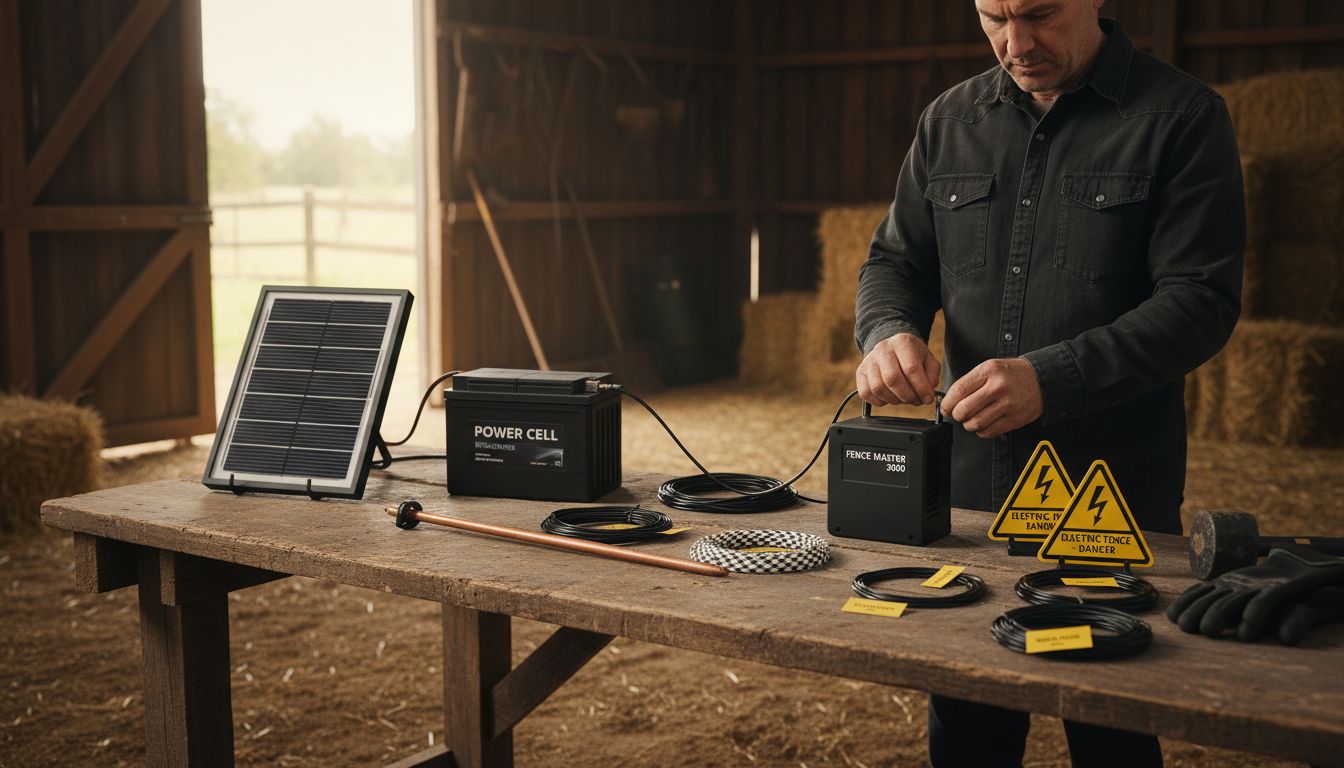More than 40 percent of farmers rely on electric fencing to protect livestock and secure property lines. Selecting the right system can make the difference between peace of mind and constant worry. With so many options and safety considerations, understanding how these fences work and what sets a safe system apart helps you avoid costly mistakes and keep your animals protected.
Table of Contents
- What Is a Safe Fence Electric System?
- Types of Electric Fence Systems Explained
- How Electric Fencing Works for Livestock
- Safety Standards and Regulatory Requirements
- Risks, Common Mistakes, and Prevention Tips
Key Takeaways
| Point | Details |
|---|---|
| Safe Fence Electric System | A system designed to manage animal movements through controlled electric pulses, enhancing property security with minimal material usage. |
| Types of Electric Fence Systems | Includes configurations like single-wire, multi-wire, and virtual GPS fencing, each tailored to specific property and livestock needs. |
| Safety Standards | Compliance is crucial, encompassing voltage limits, visibility requirements, and regular inspection protocols to ensure humane and safe operation. |
| Risk Management | Common risks arise from inadequate grounding and maintenance; proactive management is essential to minimize hazards and maximize effectiveness. |
What Is a Safe Fence Electric System?
A safe fence electric system is a specialized boundary management solution designed to control animal movement and enhance property security using controlled electric pulses. According to Agricultural and Horticultural Development Board (AHDB), an electric fence system comprises multiple critical components working together to create an effective containment barrier.
The core components of a safe fence electric system typically include:

- Energiser: The central unit that generates electric pulses
- Power Source: Could be battery, solar, or grid electricity
- Earth System: Ensures proper electrical grounding
- Conductor: Typically wire or tape that carries electrical current
As Wikipedia explains, these systems function by delivering short, controlled electric shocks that deter animals or people from crossing designated boundaries. The shock is designed to be startling but not permanently harmful, creating a psychological barrier that trains animals to avoid the restricted area.
Farmers and rural property owners find safe fence electric systems particularly valuable because they provide a flexible, cost-effective alternative to traditional fencing. Unlike solid barriers, electric fences can cover larger areas with less material, adapt to terrain variations, and offer enhanced protection against wildlife intrusion. Learn more in our guide on understanding electric fence basics.
Types of Electric Fence Systems Explained
Electric fence systems come in diverse configurations designed to meet specific agricultural and property management needs. According to Wikipedia, these systems range from simple single-wire setups to advanced multi-wire configurations and even cutting-edge virtual fencing technologies.
Key types of electric fence systems include:
- Single-Wire Systems: Basic perimeter control for smaller areas
- Multi-Wire Configurations: Enhanced containment for larger livestock properties
- Virtual GPS Fencing: Innovative technology using digital boundaries
- Permanent Electrical Fences: Fixed installations for long-term property demarcation
- Temporary/Portable Electrical Fences: Flexible solutions for rotational grazing
Solar-powered electric fences represent a sustainable technological advancement in rural boundary management. As research from SCITEPRESS indicates, these systems utilize solar panels to power energizers, providing an eco-friendly solution particularly beneficial in remote areas without reliable electrical grid access.
Each electric fence system type offers unique advantages, allowing farmers and property owners to select the most appropriate solution based on terrain, livestock type, budget, and specific containment requirements.
The right system can dramatically improve property security, animal management, and overall operational efficiency.
![]()
How Electric Fencing Works for Livestock
Electric fencing represents a sophisticated animal containment technology that uses controlled electrical pulses to manage livestock movement. According to the Agricultural and Horticultural Development Board (AHDB), the system operates through an energiser sending high-voltage pulses through conductors, creating a psychological and physical barrier for animals.
The fundamental mechanism of electric fencing involves several critical steps:
- Electrical Pulse Generation: Energiser creates controlled electric pulses
- Circuit Completion: Animal contact with fence completes the electrical circuit
- Shock Delivery: Brief, startling electrical discharge occurs
- Behavioral Conditioning: Animals learn to avoid the fence boundary
Wikipedia explains that these electric shocks are designed to be brief and deterrent, not harmful, effectively conditioning livestock to respect boundaries without causing significant physical damage. The shock’s intensity is carefully calibrated to create a memorable yet safe experience that prevents repeated boundary crossing.
Learn more about portable electric livestock fencing techniques to understand how farmers can implement these systems effectively. By providing a dynamic, flexible containment solution, electric fences offer farmers an innovative approach to livestock management that is both humane and technologically advanced.
Safety Standards and Regulatory Requirements
Electric fence safety is a critical consideration for farmers and property owners implementing livestock management systems. According to Wikipedia, electric fences must comply with specific safety standards that ensure they deliver non-lethal shocks while protecting both humans and animals.
Key safety standards and regulatory requirements include:
- Voltage Limitations: Strict controls on maximum electrical output
- Visibility Requirements: Mandatory warning signs and clear markings
- Installation Guidelines: Proper grounding and equipment specifications
- Periodic Inspection Protocols: Regular maintenance and safety checks
- Animal Welfare Considerations: Ensuring humane shock parameters
The Agricultural and Horticultural Development Board (AHDB) emphasizes that proper installation and maintenance are crucial to meeting safety standards. This involves carefully selecting appropriate energizers, ensuring correct grounding, and implementing regular inspection routines to minimize potential risks to livestock and human operators.
Explore our comprehensive guide to electric fence installation to understand the critical safety considerations. Responsible electric fence management goes beyond mere containment – it’s about creating a safe, reliable system that protects both your property and the animals within it.
Risks, Common Mistakes, and Prevention Tips
Electric fence systems require careful management to ensure safety and effectiveness. According to the Agricultural and Horticultural Development Board (AHDB), common mistakes in electric fencing can significantly compromise both animal and human safety.
Key risks and prevention strategies include:
- Inadequate Grounding: Can cause system malfunction and ineffective shock delivery
- Poor Maintenance: Increases risk of electrical failures and unexpected breakdowns
- Incorrect Voltage Settings: Potential for either ineffective or overly harsh shock levels
- Improper Installation: Creates potential safety hazards for livestock and humans
- Lack of Regular Inspections: Allows undetected system deterioration
Wikipedia highlights that potential risks associated with electric fences can be mitigated through strict adherence to safety guidelines and consistent maintenance protocols. Farmers must prioritize regular system checks, ensure proper equipment selection, and maintain clear safety zones around electric fencing installations.
Learn more about proper electric fence installation techniques to minimize potential risks. Proactive management and understanding of your electric fence system are crucial to creating a safe, reliable livestock containment solution that protects both your animals and your property.
Enhance Your Livestock Management with Reliable Safe Fence Electric Systems
Managing livestock safely and effectively requires the right electric fencing solutions that address common challenges like proper grounding, consistent voltage, and maintenance demands highlighted in the guide. Avoid risks such as ineffective shock delivery or system failures by choosing equipment designed for safety and durability. Whether you need a single-wire setup for small pastures or a solar-powered energizer for remote locations, FenceFast.ca offers exactly the components and accessories you need to build a secure and humane electric fence.

Experience peace of mind knowing your animals are contained safely while optimizing your operational efficiency. Explore our comprehensive range of electric fencing supplies including energizers, solar panels, safety parts, and connectors at FenceFast.ca. Start upgrading your fencing system today and benefit from expert design consulting and nationwide shipping. Visit FenceFast.ca now to access solutions crafted for Canadian farmers and rural property owners who demand quality and reliability.
Frequently Asked Questions
What is a safe fence electric system?
A safe fence electric system is a boundary management solution that uses controlled electric pulses to deter animals and enhance property security. It typically includes an energiser, power source, earth system, and conductor.
How does electric fencing work for livestock management?
Electric fencing works by delivering short, controlled electric shocks through conductors when an animal makes contact with the fence. This creates a psychological barrier that trains livestock to avoid crossing the boundary without causing permanent harm.
What are the main types of electric fence systems?
The main types of electric fence systems include single-wire systems for small areas, multi-wire configurations for larger properties, permanent electrical fences for long-term use, temporary/portable systems, and innovative virtual GPS fencing.
What safety standards should be followed when using electric fences?
Safety standards for electric fences include voltage limitations, visibility requirements (such as warning signs), proper installation and grounding guidelines, periodic inspection protocols, and compliance with animal welfare considerations.
